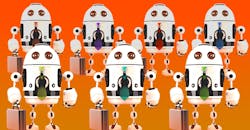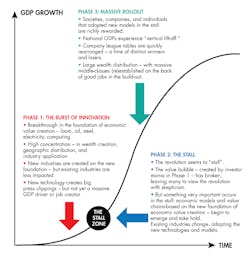What to Do When Machines Do Everything? Don’t Panic!
Download this article in PDF format.
In terms of the future of smart machines, the Internet of Things (IoT), and artificial intelligence (AI), it more or less comes down to “Like It or Not, This Is Happening.” The quoted statement is a section in the first chapter of the book What to Do When Machines Do Everything from Cognizant Technology Solutions.
"What to Do When Machines Do Everything" offers deep insight on how emerging technologies like artificial intelligence and the Internet of Things will change our labor force and production industries.
The authors do not sugar-coat the inevitable future. In chapter one, they state how this next stage of technology and business is the same as what we have experienced in the past. Just as “the First Industrial Revolution was powered by the invention of the loom, the second by the steam engine, and the third by the assembly line, the fourth will be powered by the machines that seem to think—what we refer to in these pages as “systems of intelligence.”
What is needed for many business leaders, managers, and engineers are guidelines on how to navigate their focus, products, and labor force in this emerging market. What to Do When Machines Do Everything walks the reader through the next stages of the fourth industrial revolution. It includes covering our past, the effect this will have on jobs, the new smart tools to be used, how to use data as our new oil, automation, digital instrumentation, and how to innovate the future.
(From right to left) Malcolm Frank is the executive vice president of strategy and marketing at Cognizant. Paul Roehrig is the vice president of strategy and marketing for the Cognizant Digital Business and a founder of the Center for the Future Work. Ben Pring leads Cognizant’s Center for the Future Work.
The Future of Jobs Under an AI World
With any change, there will be fallout and certain tasks and jobs will become automated. However, the current predictions are more bark than bite. The Oxford University prediction is the most dire, estimating that 47% of United States jobs will be automated away by 2025. The authors of the book are quick to tear this claim down, though.
There are an estimated 160 million jobs in the U.S. workforce. The prediction would mean that 75 million jobs would be lost. Extend this prediction to all G7 countries across the world, and 173 million jobs would be eliminated via the new technology wave. To compare, 173 million is larger than the population of Russia or the combined workforce of Germany, United Kingdom, France, Italy, Australia, and Canada. The math does not make sense.
The realistic expectation is that 12% of jobs will be lost to automation over the next 10 to 15 years. And while there will be a loss of 19 million jobs, the authors are quick to point out that 21 new million jobs will be created as a direct result of the new technology stage. If unemployment rates stay constant till 2025, the new technology wave will change the labor force of industrialized nations in three ways:
- Job automation: 12% of existing jobs are will be at risk for being taken over by modern automated systems.
- Job enhancement: 75% of all existing jobs will be enhanced or changed by the new technology. This will lead to greater output for all current jobs.
- Job creation: 13% of net new jobs will be created as the technology creates new revenue opportunities.
In the grand scheme of things, what will be automated are the specific tasks of certain jobs. Jobs themselves will be augmented by the introduction of automation technology. According to research from the Bureau of Labor Statistics and Forrester Research Inc., production and installation/maintenance/repair will be impacted by automation, both from 6% in 2015 to 60% and 61%, respectively, in 2022. Management and business-related jobs will be impacted by 92% in 2022.
Defining the New Machine
The diagram above is the anatomy of a system of intelligence. It shows how we can get from the experience of machines and humans all the way to developing an infrastructure to benefit industry.
The new machine ushering in the new technology wave will be a system of intelligence that combines software (algorithms, business rules, machine-learning code, predictive analytics), hardware (servers, sensors, mobile devices, connectivity), data (contextualized and real-time), and lastly, the input of human operators.
Software now has the ability to create its own processes. It can recognize patterns and create new functions and improvements to help better the task. Companies using this technology today are organizations like Facebook and Uber.
Processing power today is miles of where we were just 10 years ago, with the technology growing at an exponential rate. The increased capacity we have to analyze and calculate helps industry perform at a faster and more efficient rate. And the driving force behind all of this analyzation and software power is the abundance of data. Data is the fuel or the oil of the new economy. It’s what is pushing the innovation forward. By capturing the data, we are creating better automation and products.
Today, automation and AI are in its infancy. We are in the scope of Narrow AI (also known as weak AI), which is being used by Facebook, Amazon, Netflix, and Google (FANG) types of vendors. FANG vendors are using Narrow AI to create voice assistants like Siri or Alexa and intelligent GPS like Waze. But that is not the end game.
There will be General AI on the level of movies like Ex Machina, where the machine can determine the task done just by observational input. Then there will be Super AI—AI that can create other intelligent life almost on a robot-takeover level. However, worrying about this is an exaggeration. As pointed out in the book, Andrew Ng, Chief Scientist at Baidu Research, points out, “Worrying about [general or super] AI is like worrying about overpopulating on Mars before we’ve even set foot on it.”
The S-curves lay out the different industrial revolutions we have undergone as a society. With each curve, there is innovation, stall, rapid expansion, and then maturity. If we take the internet as an example, innovation came with the burst of computers, and the stall was the internet bubble burst. We are currently in the stages of rapid expansion, with companies like Facebook, Siemens, and Nike using the innovations of the last 15 years to mature the products of the digital age.
Setting forth in this environment will require a change in mentality. Learning how to leverage the data is the most crucial. Though it has parallels to oil, data differs in that it is cheap to mine as we continue to interconnect and add sensors to our devices, and infinite in that the number of devices in the world is increasing. Moreover, it is proprietary in nature, belonging to a single entity or company; cheap to distribute; and exponentially valuable. The authors predict that companies that properly use data can decrease cost by 8% and increase revenue by 8.4%.
How to Invest in the Future
To help navigate the fourth industrial revolution, Cognizant worked with Global 2000 companies to develop a structured approach called AHEAD:
Automate: Using the modern technology tools to create automated processes such as computer software, robots, sensors, etc. Examples are Uber for taxi dispatching, or collaborative robots for picking and packaging services.
Halo: Leveraging the data exhaust generated by products and people via their connected and online behaviors to create customer experiences that continue to evolve.
Enhance: Using computer systems and tools like AI to increase the output of jobs.
Abundance: Through the use of new technology, having the ability to lower the price point of existing offers, akin to Henry Ford and the automation line.
Discovery: Leveraging AI to create new products, services, and industries, just like the light bulb led to radios, television, and transistors.
The process of how to automate and get started in the fourth industrial revolution involves four steps:
1. Set your 25% - 25% automation imperative.
2. Find your process automation targets.
3. Break through the “brass wall.”
4. Build a repeatable process to obliterate work.
The goal of automation is to reduce cost by 25% and increase productivity by 25%. This will force your team and company to take the goal seriously and produce results. To reach that 25%, you must find your targets. These targets should include tasks that demand low human judgement (repeatable manual actions), low levels of empathy (robots do not need empathy to be repeatable and accurate in a task, but do for dealing with customer service), and anything that requires the handling or generating of data. There will be too much data in the future for humans to process; best leave it to the machines.
The S-curve highlights in greater detail the three stages of each revolution: the burst of innovation, the stall (and gestation period of technology), and the massive build-out into maturity.
Many employees within a corporate structure are familiar with the idea of the “brass wall”: Middle-level workers and management that refuse to adopt new policies or work styles based on their years of experience and fear of the learning curve.
Scores of engineers have expressed concerns that automation will be a “job killer,” preferring instead to stick with “tried-and-true” methods. These employees will require retraining to handle the new technology and protocols, or will ultimately be let go from their positions. It is the true definition of adapt to survive.
Lastly, building a repeatable process is crucial for continued success. Developing a strategy on how to automate not just one process, but all of them, will be an indicator on how well your company can continue down the path. The steps to automate most tasks are the same:
1. Set your automation strategy
2. Start with small level tasks
3. Apply the new machines and technology
4. Develop a prototype
5. Pilot and scale up the process
6. Analyze results for process improvement
7. Repeat
The book What to Do When Machines Do Everything delves deeper into all of these steps and ideas, and includes a list of extensive references for all their data and analysis. They continue their thought process into other chapters on, for instance, how to enhance human performance, innovation of the digital economy, and the future of coding. I highly recommend the book for any futurists out there who want a leg up on the shape of things to come.






